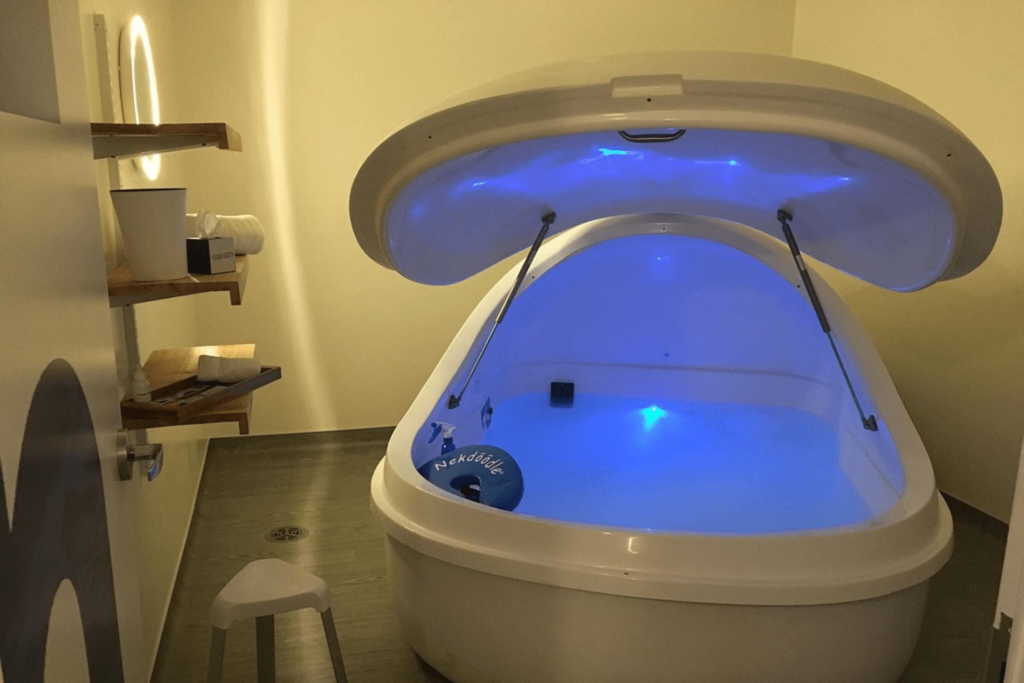What is Float Therapy and How Can It Help You Relax and Recharge?
Float therapy, also known as floatation therapy, is a wellness practice where you relax inside a special tank filled with warm water mixed with a high amount of Epsom salt. The salt makes your body float naturally, just like in the Dead Sea. The tank is quiet and dark, which means no noise, lights, or distractions. This calm space allows both your mind and body to deeply relax.
A typical float therapy session lasts about 60 to 90 minutes. The main purpose of a sensory deprivation tank is to give your brain and body a break from outside stimulation so they can reach a state of recovery and calmness. People often use floating to reduce stress, ease tension in their muscles, and improve overall health.
Key facts about float therapy:
- Also called isolation tank therapy or sensory deprivation float therapy
- Uses Epsom salt for floating and soothing sore muscles
- Helps you rest deeply by removing outside distractions
- Popular for stress relief, better focus, and mental clarity
In simple terms, float therapy – what is it? It is a way to recharge your body and mind by giving them a quiet, weightless place to rest.

What are the Health Benefits of Float Therapy?
The health benefits of float therapy are one of the main reasons it is popular around the world. By calming your mind and taking pressure off your body, floating supports both mental and physical wellness.
Main float session benefits include:
- Stress relief that helps you release daily tension
- Pain reduction as floating takes pressure off joints and muscles
- Better sleep, with deeper and longer rest after sessions
- Improved focus and creativity through sensory deprivation
- Emotional balance, including support for anxiety and depression
The benefits of floatation tanks also include better circulation, lower blood pressure, and faster recovery after exercise. The magnesium in Epsom salt is absorbed through the skin, helping muscles relax and reducing inflammation.
In short, float tank therapy benefits include:
- A calmer and clearer mind
- Faster physical recovery and pain relief
- Balanced mood and emotional wellbeing
- More restful and refreshing sleep
When people ask, “What are the benefits of float therapy?” the answer is simple. It naturally helps both the body and mind reset.

How Can Float Therapy Help Reduce Stress and Anxiety?
Stress and anxiety are some of the most common reasons people try floating. With busy lifestyles and constant exposure to screens and noise, it can feel impossible to relax. A float therapy session provides a unique break from these pressures.
Inside a sensory deprivation float tank, you experience total calm. The quiet, dark, and weightless environment lowers cortisol, the stress hormone, and encourages your nervous system to relax. Many people who struggle with racing thoughts, often called float tank anxiety, find that floating helps them finally slow down.
Float therapy for relaxation works by:
- Reducing outside stimulation so the mind can rest
- Slowing breathing and lowering heart rate
- Allowing thoughts to settle naturally
- Giving the body space to release tension
Benefits of sensory deprivation float tanks for stress and anxiety include:
- A calmer mind with fewer racing thoughts
- Lower blood pressure
- Improved mood and emotional balance
- Relief from constant mental chatter
Floating may not solve everything, but even one or two sessions often leave people feeling calmer, lighter, and more at peace.
How Can Float Therapy Help Relieve Pain?
Pain relief is another important reason people choose floating. Whether it is arthritis, back pain, or sore muscles, the float deprivation tank benefits can make a big difference.
When you float, your body is completely weightless, which removes pressure from joints, the spine, and muscles. This allows the body to fully relax and heal. The magnesium in Epsom salt also reduces inflammation and muscle soreness, which makes floating especially helpful for conditions such as fibromyalgia, migraines, and chronic pain.
Pain-related benefits of float therapy include:
- Relieves pressure on the back and joints
- Reduces muscle inflammation
- Supports faster recovery after workouts
- Helps manage chronic pain without medication
Float session therapy can help with:
- Sports injuries
- Recovery after surgery
- Headaches and migraines
- General stiffness and soreness
For anyone tired of living with constant pain, floating provides a gentle, natural way to feel better.

How Can Float Therapy Help Improve Your Sleep?
Good sleep is essential for health, but many people struggle with insomnia or restless nights. One of the most powerful effects of float therapy is its ability to improve sleep quality.
When you float, your body reaches a deep level of relaxation and your brain shifts into slower brainwave states, similar to meditation or the early stages of sleep. This is especially helpful for people who cannot stop overthinking before bedtime. The buoyancy also relieves physical discomfort that often interferes with rest.
How float therapy supports better sleep:
- Calms stress and racing thoughts before bed
- Relieves muscle pain that can disturb sleep
- Encourages natural melatonin release, the sleep hormone
- Promotes long, restorative sleep cycles
Float session benefits for sleep include:
- Falling asleep faster
- Waking up fewer times during the night
- Feeling more refreshed in the morning
- Reduced need for sleep medication
When people ask, “What are the benefits of float therapy?” the answer is simple. It naturally helps both the body and mind reset.

How Can Float Therapy Help Relieve Pain?
Pain relief is another important reason people choose floating. Whether it is arthritis, back pain, or sore muscles, the float deprivation tank benefits can make a big difference.
When you float, your body is completely weightless, which removes pressure from joints, the spine, and muscles. This allows the body to fully relax and heal. The magnesium in Epsom salt also reduces inflammation and muscle soreness, which makes floating especially helpful for conditions such as fibromyalgia, migraines, and chronic pain.
Pain-related benefits of float therapy include:
- Relieves pressure on the back and joints
- Reduces muscle inflammation
- Supports faster recovery after workouts
- Helps manage chronic pain without medication
Float session therapy can help with:
- Sports injuries
- ecovery after surgery
- Headaches and migraines
- General stiffness and soreness
For anyone tired of living with constant pain, floating provides a gentle, natural way to feel better.
Float Therapy vs Meditation: What is the Difference?
Float therapy and meditation both calm the mind and reduce stress, but they work in different ways.
Meditation requires active practice. You focus on your breath, a word, or your thoughts to reach calmness. In contrast, a float therapy session naturally places you in a meditative state without much effort. The sensory deprivation tank removes distractions, making it easier for beginners to experience mindfulness.
Pain-related benefits of float therapy include:
- Key differences between meditation and float therapy:
- Meditation requires focus and practice
- Float therapy creates calmness instantly through the environment
- Many people combine the two by meditating inside the float tank
Benefits of floatation tanks compared to meditation:
- Easier for those who find traditional meditation difficult
- Helps maintain mindfulness for longer periods
- Works well for both beginners and experienced practitioners
While meditation is a skill you develop over time, floating provides a simple and direct way to reach the same calming state. Together, they can complement each other beautifully.

How Can Floating Enhance Mental Clarity and Boost Creativity?
Many artists, professionals, and entrepreneurs use floating to clear their minds and unlock creativity. The unique environment of sensory deprivation float therapy allows the brain to enter a calm state where new ideas often appear.
Why float therapy supports clarity and creativity:
- Fewer distractions, so the brain can focus fully
- Improved blood flow to the brain for better alertness
- Relief from stress, which clears mental blocks
- Encourages new and creative ways of thinking
Float session benefits for creativity include:
- Sharper focus on projects or tasks
- Fresh inspiration and original ideas
- Clearer thinking during stressful situations
- Better memory and learning ability
Many people report leaving a float therapy session with renewed energy, fresh ideas, and the ability to see problems from a new perspective.

What to Expect During Your First Float Session
If you’ve never tried float session therapy before, it’s normal to feel a little unsure. A float session takes place in a private room with a special tank filled with warm water and Epsom salt. The salt makes the water so dense that your body floats naturally, without effort. This is why float therapy is also called isolation tank therapy or sensory deprivation float therapy.
When you arrive, the staff will guide you through the steps. You’ll usually shower first, then enter the tank. Some tanks are pods with a lid, but you don’t have to close it if you don’t feel comfortable. There are also larger float rooms for people who don’t like enclosed spaces.
The session usually lasts 60 to 90 minutes. Inside the tank, there’s no sound, no light, and almost no feeling of touch. This helps your body and brain fully relax. The effects of float therapy include less stress, more focus, and a calm mind.
What you can expect:
- A clean, private room.
- Warm water mixed with Epsom salt.
- Options to leave the tank open.
- 1 — 1.5 hours of floating.
- Relaxation time after your session.
Your first session may feel different at the start, but most people leave feeling the benefits of float therapy right away.
How Can Float Therapy Benefit Athletes and Speed Up Recovery?
Athletes are big fans of float therapy because it helps them recover faster and avoid injuries. Many sports teams and professionals now use float tank therapy benefits as part of their routine.
When you train or play sports, your body takes on stress. Floating helps in two big ways: the magnesium in the water relaxes muscles, and the weightless environment takes pressure off joints. This helps your body heal faster.
Float therapy session benefits for athletes:
- Less muscle soreness.
- Better flexibility and movement.
- Faster healing from small injuries.
- Mental focus before games.
- Stress relief during heavy training.
One of the most useful health benefits of float therapy is how it reduces lactic acid, which causes muscle pain. The effects of float therapy also improve sleep, which is key for recovery.
Floating isn’t just physical. The float deprivation tank benefits also include mental calmness, which can help athletes prepare and stay focused.
Whether you’re a pro or just active for fun, float therapy can improve recovery, performance, and overall health.

What Happens to Your Body and Mind During Float Therapy?
You may be asking: Float therapy—what is it? It’s a wellness treatment where you float in a tank filled with salty, warm water. The goal is to block outside distractions so your body and mind can rest. This is why it’s called sensory deprivation float therapy.
The science behind float therapy comes from three main things:
- Epsom Salt – The water contains a lot of magnesium sulfate. This makes floating easy and may also relax muscles.
- Sensory Deprivation – With no light, sound, or movement, your brain gets a chance to rest and reset.
- Brainwaves – Research shows that during a float therapy session, your brain can shift into theta waves. These waves happen in deep meditation or right before sleep, helping creativity and relaxation.
Health benefits of float therapy supported by science:
- Lower stress hormones.
- Better blood flow and less inflammation.
- Improved sleep.
- Faster muscle recovery.
The purpose of sensory deprivation tank sessions is simple: give your body and brain a break so they can heal and recharge.

How Can Float Therapy Improve Mental Health?
Float therapy is becoming popular for mental wellness. It’s not a replacement for medical care, but it can help reduce stress, anxiety, and depression symptoms.
People who try float therapy for depression or float tank anxiety sessions often say they feel lighter, calmer, and more balanced. In the quiet, your brain gets a break from all the noise and stress of daily life. This can lower stress hormones and boost mood.
Mental health benefits of floatation tanks:
- Less anxiety and depression.
- A calmer mood.
- Better sleep.
- More focus and mindfulness.
The benefits of floatation tanks also support emotional wellbeing by giving people space to relax and recharge. The float tank therapy benefits help you feel more balanced and in control.
What Are the Truths Behind Common Float Therapy Myths?
Float therapy sounds unusual, so it’s common to hear myths about it. Let’s clear up the most common ones.
Myth 1: Floating feels claustrophobic.
Truth: Tanks are bigger than people think, and you can keep the lid open.
Myth 2: Floating isn’t safe.
Truth: The salty water makes you float easily, and the salt keeps the water clean.
Myth 3: It’s just for relaxation.
Truth: The benefits of float therapy include pain relief, faster recovery, better sleep, and mental clarity.
Myth 4: You need meditation skills.
Truth: Anyone can float. Your body naturally relaxes in the tank.When people understand the real effects of float
therapy, they often feel more comfortable trying it—and enjoying the many benefits.

How Can I Make the Most of My Float Therapy Experience?
A float therapy session is simple, but a few tips can make your experience even better.
Before your float:
- Avoid coffee or caffeine for a few hours—it can make you restless.
- Take a shower before and after your float.
- Don’t shave or wax that day (the salt can sting).
- Use earplugs if you prefer quiet.
During your float:
- Try different positions for comfort.
- Keep the lid open if you feel uneasy.
- Focus on your breathing to relax your mind.
The benefits of sensory deprivation float tanks are strongest when you let go and stop forcing your thoughts. If your mind wanders, that’s okay. Just return to your breath.
After your float:
- Drink water.
- Take your time before heading back into your day.
Many people say the calm feeling and effects of float therapy last for hours or even days after a session.

How Can Float Therapy, Meditation, and Yoga Work Together for Deep Relaxation?
Combining Meditation, Yoga, and Floating for Ultimate Relaxation
If you’re wondering, “float therapy what is it?”, it’s more than just floating in water. It’s about calming your body and mind. When you mix it with meditation or yoga, you can feel even deeper benefits of float therapy.
Floating shuts out noise, light, and stress, making it easier for the mind to rest. Meditation does the same, but when you add floating, the calmness comes faster and feels stronger. Yoga helps your muscles relax, so when you float, your body feels lighter.
The science behind float therapy shows that it lowers stress hormones and slows down brain activity, which is very similar to mindfulness. That’s why combining these practices is powerful.
Benefits of combining floating with mindfulness:
- Easier and deeper meditation.
- Calms anxious thoughts (float tank anxiety relief).
- Yoga plus floating = less body tension.
- More focus and emotional balance.
Floating with mindfulness is not just about rest—it’s about connecting your body and mind. This is one of the biggest benefits of floatation tanks.
How Can Float Therapy Help Busy Professionals Recharge and Reduce Stress?
Quick Mental Recharge for Stressful Work Schedules
For people with busy jobs, stress and exhaustion are common. Float therapy for relaxation is one of the fastest ways to recharge. In just one hour, a float therapy session can feel like several hours of deep rest.
The float tank therapy benefits are perfect for busy workers. Floating takes away all outside distractions, so your brain can reset. This helps with focus, creativity, and clear thinking. Many professionals say the effects of float therapy help them avoid burnout and stay more balanced.
The benefits of sensory deprivation float tanks include lower stress, better sleep, and faster recovery from mental tiredness. This is why many top business leaders and athletes use isolation tank therapy regularly.
Benefits of floating for professionals:
- Stress melts away quickly.
- Better sleep and energy.
- Improved focus at work.
- Boost in creativity and problem-solving.
- Relief from body tension and headaches.
For busy people, floating once a week or even once a month can make a big difference. This is one of the most practical health benefits of float therapy.

Home Float Tanks vs. Spa Float Therapy: Which is Better?
Float therapy, also called sensory deprivation float therapy, is when you lie in warm water mixed with Epsom salt so your body floats easily. Many people try it because of the health benefits of float therapy, such as stress relief, better sleep, and feeling calmer. But should you do it at home, or go to a spa? Let’s look at both.
Having a float tank at home is convenient. You can use it anytime and don’t have to book appointments. Over time, it can save money if you float often. But buying and setting up a tank costs a lot, and keeping the water clean takes effort.
At a spa, you get professional equipment, a quiet setting, and staff to help if needed. The spa environment also makes it easier to relax. The downside is paying for each float therapy session and traveling to the center.
Pros of Home Float Tanks:
- Private and comfortable.
- Use anytime without booking.
- Saves money if used often.
Cons of Home Float Tanks:
- Very expensive to buy and install.
- Needs regular cleaning and care.
- May not feel as high-quality as spa tanks.
Pros of Spa Float Centers:
- Clean, well-maintained tanks.
- Peaceful spa setting adds to the effects of float therapy.
- Staff available for help.
Cons of Spa Float Centers:
- Higher cost per float session therapy.
- You need to book and travel.

Kids and Float Therapy: Is It Safe?
How Float Therapy Can Help Teens with Stress and Focus (with Precautions)
Parents sometimes ask if kids or teens can try float therapy. The short answer is yes—with care. The benefits of float therapy for young people can be very helpful. Teens today face a lot of school, sports, and social pressure. Floating gives them a calm space to relax and recharge.
For teens, floating may ease stress, help them sleep better, and even improve focus. Some families use float therapy for depression or anxiety as a natural support. Still, kids may feel nervous about being in a quiet tank. Shorter sessions and proper guidance help.
Float deprivation tank benefits for teens include:
- Stress relief and calmer moods.
- Better focus during school or exams.
- Improved sleep.
- A safe break from busy routines.
Safety tips for kids and teens:
- Ask a doctor first.
- Start with short floats (20–30 minutes).
- Explain the process clearly.
- Supervise younger kids.
- Don’t float with cuts, wounds, or skin issues.
With the right precautions, isolation tank therapy can be safe for teens and give them the same calming float session benefits adults enjoy.
DIY Float Therapy: Can You Do It at Home?
Exploring Simple Ways to Mimic Float Therapy Benefits Safely at Home
Not everyone can buy a float tank or visit a spa, but you can still try a simpler version at home. While it’s not the same as the full purpose of sensory deprivation tank floating, you can still enjoy some benefits of float therapy in your own bathroom.
The easiest way is to use your bathtub. Fill it with warm water and Epsom salt to make yourself more buoyant. Turn off the lights or use candles, wear an eye mask, and play soft music. This helps mimic a float therapy session.
The float tank therapy benefits like stress relief, muscle relaxation, and mental calmness can still be felt, even without a professional setup.
DIY float therapy tips:
- Use Epsom salt in warm water.
- Add a bath pillow or float cushion.
- Dim lights or light candles.
- Listen to calm sounds or guided meditation.
- Stay quiet and relaxed.
Float session benefits at home:
- Relaxation after a busy day.
- Better sleep.
- Relief from muscle aches.
- Low-cost way to relax.
It’s not full sensory deprivation float therapy, but it’s a simple way to get many of the same float deprivation tank benefits.

How Often Should You Float?
Recommendations Based on Goals like Stress Relief, Pain Management, or Creativity
A common question is: how often should you float? The answer depends on what you want from it. The effects of float therapy build up over time, so the more regularly you float, the more benefits you notice.
For stress and relaxation, one float therapy session every 1–2 weeks works well. People with chronic pain or anxiety may benefit from floating two to three times a week. Creative people often float when they need new ideas or want a mental boost.The science behind float therapy shows that regular floating helps train the body and mind to relax faster.
Floating frequency by goals:
- Stress relief: Once every 1–2 weeks.
- Pain management: 2–3 times weekly.
- Mental health (like float therapy for depression or anxiety): Once a week.
- Creativity boost: As needed during projects.
- General wellness: Once a month.
Float session benefits when done often:
- Stronger stress resistance.
- Long-term anxiety relief.
- Ongoing pain control.
- Better focus and sleep.
- More creativity and clear thinking.
The key is consistency. Floating once feels great, but regular sessions unlock the deeper benefits of sensory deprivation float tanks.

Testimonials and Real-Life Experiences with Float Therapy
Sharing Stories to Build Trust and Engagement
Hearing real stories helps people understand what floating is like. Many people who try float session therapy say it feels like the most relaxed they’ve ever been.
Some share that one float therapy session eased their stress right away. Others say it helped with chronic pain, improved focus, or gave them creative ideas. The benefits of floatation tanks are often described as life-changing.
For example, one business owner said weekly floating reduced their anxiety, helped them sleep better, and made work less overwhelming. A student explained that float therapy for depression gave them a natural way to cope with stress during exams.
Athletes also talk about the float tank therapy benefits for faster recovery. The salt eases sore muscles, while the quiet space helps their mind recharg
Common experiences include:
- Feeling deeply calm and refreshed.
- Less stress, anxiety, and depression symptoms.
- Clearer thinking and problem-solving.
- Better sleep and energy.
- Relief from aches and pain.
These stories show how wide the float deprivation tank benefits can be—for the mind, body, and overall lifestyle.

